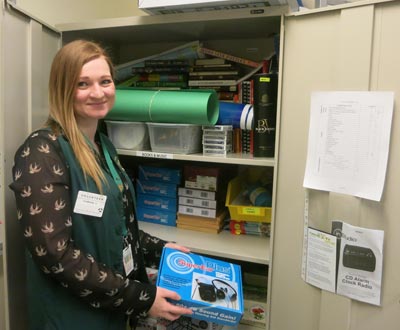
HELP volunteer Siobhán Giles looks for games in the activity cupboard. HELP volunteers visit one-on-one with patients to provide social interactions that can help prevent hospital acquired delirium. (Photo: UHN News)
The many volunteers lending a hand at the University Health Network can often be recognized by their trademark maroon or blue vests. But on the General Internal Medicine (GIM) units at Toronto Western Hospital (TWH), there is another colour that has been added to this mix: green.
Volunteers in green vests are part of the Hospital Elder Life Program (HELP), a group of more than 70 people dedicated to reducing delirium rates and functional decline of admitted patients as well as providing them with some companionship and opportunities for physical activity.
For an inpatient, a hospital unit can sometimes be a lonely place – especially for elderly patients who are admitted for a long period of time. Although staff do their best to make patients feel comfortable and family members visit when possible, there are few opportunities for patients to have prolonged contact with people unrelated to their medical care, or to take part in activities outside of their hospital rooms.
HELP aspires to address that need.
National Volunteer Week
April 10-16, 2016
The program, developed by Yale University and available in some hospitals in North America and around the world, was brought to TWH's 8A and 8B units in 2011 by TWH's Geriatric In-Patient team. The team was looking for creative ways to engage GIM patients and help manage hospital-acquired delirium – a temporary delirious state caused by infection, dehydration, isolation or any number of reasons where a patient experiences an altered level of consciousness.
Today, HELP is managed by Katherine Reece, HELP coordinator; Senait Werkelul, nursing specialist; and Claudia Ortins, TWH Volunteer Program coordinator.
"The GIM units serve many patients with dementia. These are busy, hectic units and staff didn't have time to establish a program to provide one-on-one interaction with patients," explains Reece, who is also an occupational therapist on the unit.
"Implementing the HELP program not only allowed us to create the possibility for these interactions, but also gives volunteers the opportunity for a more meaningful experience working directly with patients during their volunteer hours."
People interested in volunteering for HELP, which requires a minimum of a one-year commitment, are first evaluated by UHN Volunteer Resources and referred to the program for additional training. There, volunteers learn the interventions to help address delirium.
"With every visit, volunteers are given an assignment," says Reece. "For instance they can assist at meal time, which keeps the patient hydrated and engages them socially. Or they can participate in a number of therapeutic activities such as playing games, reading newspapers, going for walks, reminiscing or listening to music with the patient. All of these help keep patients' minds engaged."
The goal of HELP is to provide three visits per day for each patient who has been screened for the program. Volunteers visit patients seven days per week between 9 a.m. and 8 p.m., for 3.5-hour shifts.
The program has been a very rewarding experience for Siobhán Giles, 32, who has been volunteering with HELP since it first started in 2011.
"When I applied to be a volunteer at UHN, I was recommended for the HELP program," Giles recalls. "I had just completed my studies in social work and psychology so the program made sense as a way to apply and round out what I'd learned at school."
Five years on and now working in real estate, Giles continues to make time to participate as a HELP volunteer.
"I really feel this program makes a difference for patients," she says. "We're able to spend time with them, go for walks, and do range of motion exercises. We focus on what the patient wants to do and wants to talk about, and you can tell it really brightens their day."
Giles has seen the program transform some patients from being aggressive and difficult with the staff and volunteers to having a complete change in demeanour – to the point that family members also notice the difference. With patients feeling happier and more engaged, it is easier for them to transition to the next part of their care plan - whether it be being discharged or transferred to a long-term care facility.
It's not just patients who benefit from HELP. Giles has found being a HELP volunteer has taught her a lot too.
"When I was in school, I thought older people might be a difficult population for me to work with since I hadn't interacted with many elderly people other than my grandparents," she says.
"Being a HELP volunteer has shown me how much elderly people have to offer in terms of great stories, wisdom and life lessons, and they shouldn't be discounted as society is sometimes quick to do. I really enjoy my time in the program and I hope the other volunteers get as much value from it as I do."
